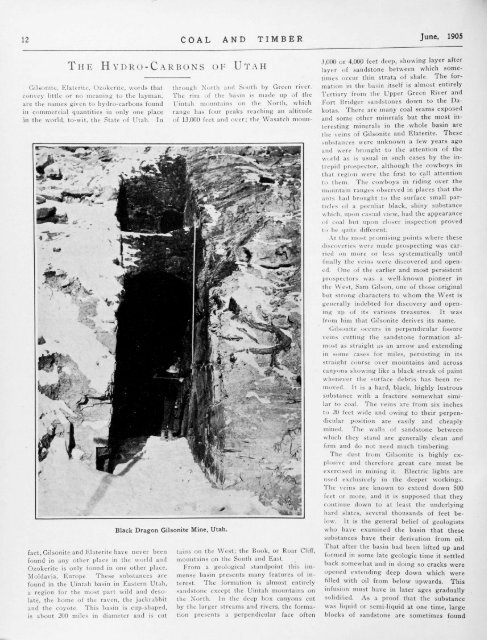You also want an ePaper? Increase the reach of your titles
YUMPU automatically turns print PDFs into web optimized ePapers that Google loves.
12 COAL AND TIMBER June, 1905<br />
THE HYDRO-CARBONS OF UTAH<br />
Gilsonite, Elaterite, Ozokerite, words that through North and South by Green river.<br />
convey little or no meaning to the layman. The rim of the basin is made up of the<br />
are the names given to hydro-carbons found L'intMih mountains on the North, which<br />
in commercial quantities in only one place range has four peaks reaching an altitude<br />
in the world, to-wit, the State of Utah. In of 13.000 feet and over; the Wasatch moun-<br />
fact, Gilsonite and Elaterite have never been<br />
found in any other place in the world and<br />
Ozokerite is only found in one other place,<br />
Moldavia, Europe. These substances are<br />
found in the Uintah basin in Eastern Utah,<br />
a region for the most part wild and desolate,<br />
the home of the raven, the jackrabbit<br />
and the coyote. This basin is cup-shaped,<br />
is about 200 miles in diameter and is cut<br />
Black Dragon Gilsonite Mine, Utah.<br />
tains on the West; the Book, or Roar Cliff,<br />
mountains on the South and East.<br />
From a geological standpoint this immense<br />
basin presents many features of interest.<br />
The formation is almost entirely<br />
sandstone except the Uintah mountains on<br />
the North. In the deep box canyons cut<br />
by the larger streams and rivers, the formation<br />
presents a perpendicular face often<br />
3,000 or 4,000 feet deep, showing layer after<br />
layer of sandstone between which sometimes<br />
occur thin strata of shale. The formation<br />
in the basin itself is almost entirely<br />
Tertiary from the Upper Green River and<br />
Fort Bridger sandstones down to the Dakotas.<br />
There are many coal seams exposed<br />
and some other minerals but the most interesting<br />
minerals in the whole basin are<br />
the veins of Gilsonite and Elaterite. These<br />
substances were unknown a few years ago<br />
and were brought to the attention of the<br />
world as is usual in such cases by the intrepid<br />
prospector, although the cowboys in<br />
that region were the first to call attention<br />
to them. The cowboys in riding over the<br />
mountain ranges observed in places that the<br />
Mints had brought to the surface small particles<br />
of a peculiar black, shiny substance<br />
which, upon casual view, had the appearance<br />
of coal but upon closer inspection proved<br />
to be quite different.<br />
At the most promising points where these<br />
discoveries were made prospecting was carried<br />
on more or less systematically until<br />
finally the veins were discovered and opened.<br />
One of the earlier and most persistent<br />
prospectors was<br />
a well-known pioneer in<br />
the West, Sam Gilson, one of those original<br />
but strong characters to whom the West is<br />
generally indebted for discovery and opening<br />
up of its various treasures. It was<br />
from him that Gilsonite derives its name.<br />
Gilsonite occurs in perpendicular fissure<br />
veins cutting the sandstone formation almost<br />
as straight as an arrow and extending<br />
in some<br />
cases for miles, persisting in its<br />
straight course over mountains and across<br />
canyons showing like a black streak of paint<br />
whenever the surface debris has been removed.<br />
It is a hard, black, highly lustrous<br />
substance with a fracture somewhat similar<br />
to coal.<br />
The veins are from six inches<br />
to 20 feet wide and owing to their perpendicular<br />
position are easily and cheaply<br />
mined. The walls of sandstone between<br />
which they stand are generally clean and<br />
linn and do not need much timbering.<br />
The dust from Gilsonite is highly explosive<br />
and therefore great care must<br />
exercised in mining it. Electric lights are<br />
used exclusively in the deeper workings.<br />
The veins are known to extend down 500<br />
feet or more, and it is supposed that they<br />
continue down<br />
be<br />
to at least the underlying<br />
hard slates, several thousands of feet below.<br />
It is the general belief of geologists<br />
who have examined the basin that these<br />
substances have their derivation from oil.<br />
That after the basin had been lifted up and<br />
formed in some late geologic time it settled<br />
back somewhat and in doing so cracks were<br />
opened extending deep down which were<br />
filled with oil from below upwards.<br />
This<br />
infusion must have in later ages gradually<br />
solidified. As a proof that the substance<br />
was liquid or semi-liquid at one time, large<br />
blocks of sandstone are sometimes<br />
found
















